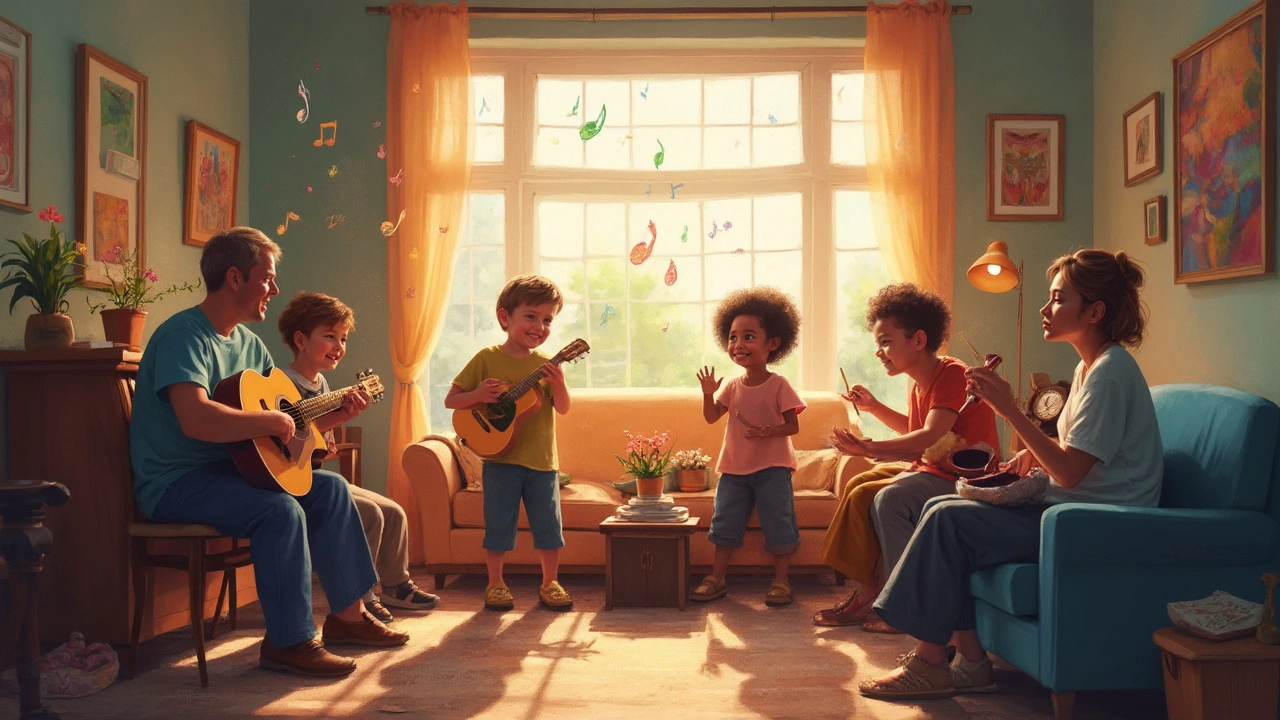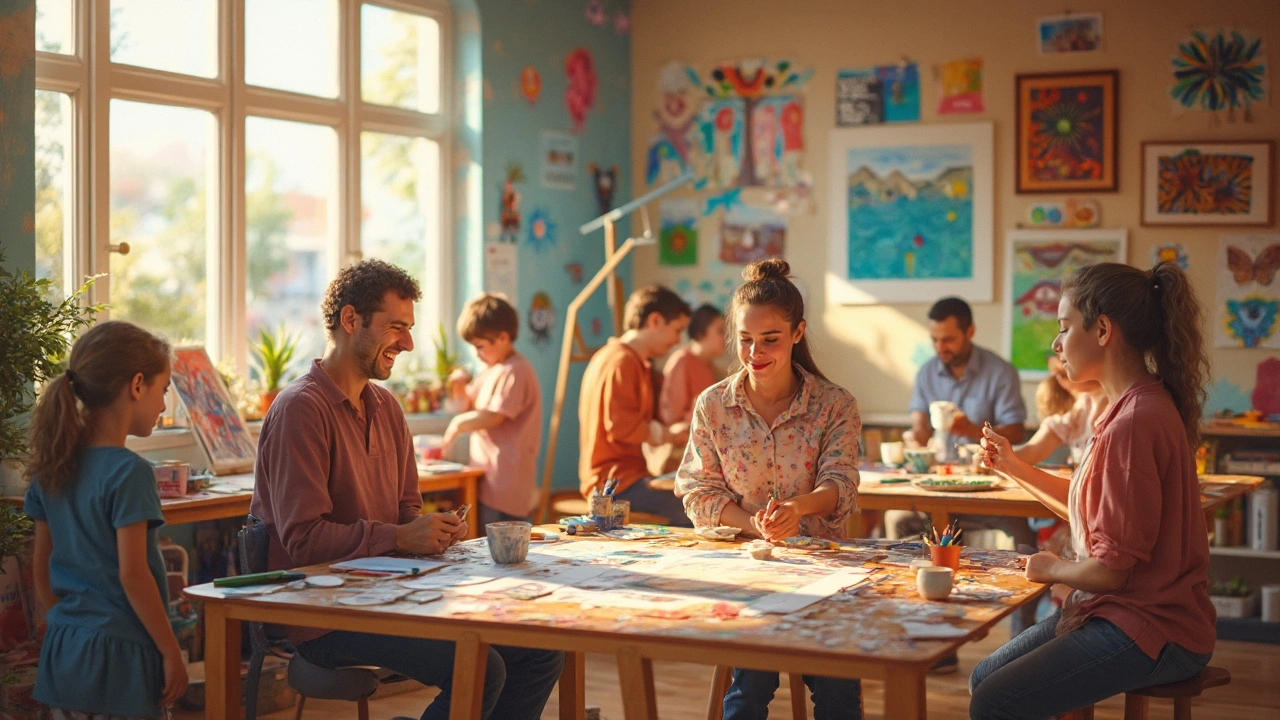If you think therapy is only about lying on a couch and talking about your feelings, you might be surprised. More people are discovering that drawing, dancing, or even banging on some drum pads can help with anxiety, stress, or old traumas. Creative arts therapies are becoming a real game-changer for how we think about mental health care.
Instead of just focusing on words, these therapies use things like painting, music, and movement. You don’t need to be Van Gogh or Beyoncé to benefit. The goal isn’t making masterpieces; it’s about expressing what’s tough to say and unlocking emotions in a new way.
This shift is big. Even schools and hospitals are bringing in art and music therapists. Kids who’ve shut down in regular therapy sometimes open up when they get to scribble with crayons or tell stories with finger puppets. Grownups often find it easier to work through anxiety or grief when they can create something with their hands or bodies.
- What Are Creative Arts Therapies?
- Why Creativity Works for Mental Health
- Key Types of Arts Therapies
- Who Benefits and How
- Technology’s Role in Arts Therapies
- Getting Started: Tips and Practical Advice
What Are Creative Arts Therapies?
Creative arts therapies blend traditional therapeutic theories with hands-on activities like painting, music, dance, drama, or writing. Instead of just talking about what’s going on, you use a creative process to figure out feelings and work through stuff that’s hard to say.
Here’s the kicker: You don’t need any art experience. Therapists guide you through activities that feel natural—maybe using paint, moving to music, or even acting out a scene. It’s less about showing off your skills and more about using creativity to explore what’s happening in your life.
There are four main types of creative arts therapies people run into most:
- Art therapy: Using visual arts like drawing, painting, or sculpting to work with feelings, memories, and personal struggles.
- Music therapy: Listening to, making, or talking about music as a tool for emotional healing and self-expression.
- Dance/movement therapy: Using body movement to address emotional or physical concerns—it can get you “unstuck” from feelings that are hard to explain.
- Drama therapy: Acting things out or telling stories to work through challenges, which helps people find new ways to cope.
These therapies are used with a wide range of groups—kids on the autism spectrum, veterans with PTSD, seniors with dementia, and regular folks who just feel burnt out. Creative arts therapies aren’t about judging your work. They help you see problems differently when talking doesn’t quite do the trick.
Surprisingly, a 2023 survey by the American Art Therapy Association showed that close to 80% of clients in art therapy said they felt calmer and more focused after just six sessions. That’s pretty wild compared to some talk therapies that can take much longer to shift how you feel.
In a nutshell, these therapies open up new ways to process tough experiences—no talent required, just a willingness to try something new.
Why Creativity Works for Mental Health
There’s real science behind why creative arts therapies can help people work through tough emotions and mental health issues. Our brains don’t just process feelings through talking—sometimes art, music, and movement reach places words can’t. When you dive into something creative, your brain releases feel-good chemicals like dopamine and serotonin. These aren’t just buzzwords—low levels of them are connected with depression and anxiety, while boosting them naturally lifts mood.
One neat fact: MRI scans show that making art can reduce activity in the brain’s fear center (the amygdala). Less activity means less stress, so those therapy coloring books aren’t just a trend—they actually work for calming nerves. Plus, using your hands or voice helps your body relax. Music is another big player. A study published in Frontiers in Psychology found that just 30 minutes of listening to or making music can lower the stress hormone cortisol in your blood.
What’s cool is that you don’t need any art or music skills. The point is getting out of your head and into a space where you can explore feelings safely. Here’s why these approaches work so well:
- Makes it easier to express tough emotions. Not everyone likes talking about feelings, especially kids and teens. Creative activities give an outlet without pressure.
- Reduces shame and self-criticism. People get stuck in their thoughts. Focusing on art or music can interrupt negativity loops and build confidence.
- Builds new coping skills. Learning how to step back, reflect, or communicate in creative ways can carry over to daily life and stressful moments.
If you’re curious about how fast these benefits can kick in, check this out:
| Creative Activity | Time Spent | Reported Improvement in Mood |
|---|---|---|
| Drawing or Painting | 45 minutes | 75% of people felt less stressed |
| Music Therapy | 30 minutes | Up to 60% reported reduced anxiety |
| Dance/Movement | 20 minutes | 50% noticed better mood right away |
The bottom line? Plugging into music therapy, art, or other creative outlets isn’t just enjoyable—it actually rewires your brain to help you manage stress, sadness, or big emotions in a healthier way.
Key Types of Arts Therapies
Folks often hear about creative arts therapies but don’t always know how many options there actually are. These therapies aren't all the same. Each one taps into different parts of the brain and body to help people heal and open up.
Art therapy puts paint, pencils, and markers right in your hands. It’s not about the finished look but about the process—getting your feelings out without saying a word. Art therapists guide you, but you call the shots on what to draw or create. Research from the American Art Therapy Association shows it’s linked to lower anxiety and stress—especially in children and trauma survivors.
With music therapy, you don’t need to play an instrument. Sometimes you just listen to a playlist chosen to help with sadness or anxiety. Sometimes you write songs or use drums to release anger. Studies from the British Journal of Psychiatry found that music therapy can reduce depression symptoms and help people connect, especially those dealing with autism or dementia.
Dance/movement therapy gets your body involved. You work with a trained pro and use simple movements or dance—no fancy footwork needed. It helps loosen up tough feelings stored in the body. According to the American Dance Therapy Association, this approach can boost mood and body confidence, even in folks who hate the idea of dancing.
Some people connect best through drama therapy. This type uses role-play, storytelling, and improvisation. It’s used in group settings and for trauma recovery. By stepping into a role, you get to try out new responses and see yourself from another angle. Research points to benefits for people coping with addiction, PTSD, or social awkwardness.
Here’s a quick breakdown of the main types and where they shine:
| Type | Main Activity | Who Benefits Most |
|---|---|---|
| Art Therapy | Drawing, painting, sculpture | Children, trauma survivors |
| Music Therapy | Listening, playing, songwriting | People with depression, autism, dementia |
| Dance/Movement Therapy | Simple movements, free dance | Those seeking body awareness or stress relief |
| Drama Therapy | Role play, storytelling | Addiction recovery, PTSD, social anxiety |
Trying these out doesn’t require any talent. It’s all about expression, not perfection. If you’re curious, most therapists offer a quick intro session where you can test out what feels comfortable for you.

Who Benefits and How
You might be thinking, Who is creative arts therapy really for? The cool part: it helps almost anyone. Kids, teens, adults, and even seniors—each group finds something that clicks for them. Let's break it down.
For kids who struggle to explain how they feel—maybe because of anxiety, trauma, or autism—drawing or acting gives them another tool besides words. Schools use creative arts therapies to help students handle stress and to boost their social skills. Sometimes, just a box of crayons or a drum circle can make a shy kid open up in ways regular therapy can’t.
Teens dealing with depression, body image, or social pressure get a lot out of art, music, or dance therapies. Making music or movement gives them a safe way to deal with big emotions and connect with others. In fact, music therapy has become so helpful for teens that some hospitals now offer it as a standard option in mental health wards.
Adults come with their own stress—job burnout, grief, or chronic illness. Painting, making music, or even writing poetry lets them process tough stuff without needing to figure out the “right” words. It’s not rare for people in addiction recovery to use drama or art in a group, helping them tell their stories and build confidence.
Even older adults, especially those with dementia or memory loss, see big benefits. Music therapy helps jog memories and lift moods, sometimes sparking smiles or conversations that medicine alone can’t. Retirement homes often offer weekly painting or singing sessions because it keeps residents social, happy, and mentally active.
| Group | Main Benefits |
|---|---|
| Children | Emotional expression, coping, better focus |
| Teens | Lower anxiety, improved mood, social skills |
| Adults | Stress relief, self-understanding, healing trauma |
| Seniors | Memory, socializing, reduced depression |
One thing to know: You don’t need to be “good at art” or have any experience to benefit. What matters is getting a chance to make, move, or play in a space that feels safe. The mental health gains show up as higher confidence, fewer symptoms, and even better relationships. That’s why so many people and clinics are giving art therapy and music therapy a serious try.
Technology’s Role in Arts Therapies
Tech is quickly changing how creative arts therapies work—and making them more accessible for people who might never set foot in a typical therapy room. The biggest game-changer? Online therapy sessions using video calls, where you and your therapist can share drawings, music, or movement from anywhere. This is a lifeline for folks in small towns or those with packed schedules.
Apps and virtual tools now let you create digital art, write music, or choreograph movement right on your phone or tablet. Tools like GarageBand, Procreate, or even TikTok are showing up in sessions. There are even therapy programs using VR (virtual reality), so someone with social anxiety can practice speaking to an audience—with total control and no real-life risk.
Here’s a look at how tech is shaping things up:
- Art therapy apps let you paint, sketch, and sculpt on digital canvases—no mess, no expensive supplies.
- Music therapy tools can auto-generate background beats or help you record and share your own songs for feedback.
- Dance/movement therapy sometimes uses motion capture tech (like game consoles) to mirror and improve movement in real time.
- Virtual support groups make it way easier to join from home, so you can stay connected even if you’re anxious being in a room with others.
The numbers back this up too. A recent 2024 survey across U.S. clinics found that almost 60% of mental health providers offering creative arts therapies now use at least one digital tool in their sessions.
| Tech Used | % of Therapists |
|---|---|
| Art & music apps | 42% |
| Online video calls | 61% |
| VR activities | 8% |
Final tip if you want to try this: check for therapists who mix in tech, or ask if you can include your favorite creative apps or online hobbies. Many pros say that mixing old-school art with new tech keeps people engaged and lets you keep practicing between sessions—right from your couch or kitchen table.
Getting Started: Tips and Practical Advice
Ready to try creative arts therapies for your mental health or for someone you care about? You don’t need fancy tools or an art degree. Here’s how to dive in—even if you’re a complete beginner.
1. Pick Your Medium
First, think about what grabs your interest. Is it music, painting, dance, or maybe drama? Each one helps folks in different ways. Art therapy can help with stress and worry by encouraging you to doodle what you can’t put into words. Music therapy is great for folks who find comfort or energy in sound—think making playlists, singing, or even just banging a drum. Don’t overthink it; whatever makes you want to move or create is a good place to start.
- Art therapy: Try coloring sheets, journaling, painting, or simple crafts at home.
- Music therapy: Sing to your favorite songs, play easy instruments, or use music-making apps.
- Dance/movement: Put on music and move how you feel—no choreography needed.
- Drama/play: Even acting out a story with toys can help kids open up.
2. Set the Scene
Find a relaxed spot where you can create without feeling judged. This can be the kitchen table, your bedroom floor, or even your car with the windows rolled up if that’s what you need. Turn off distractions and allow at least 15–30 minutes just for you.
3. Make It a Regular Thing
The benefits of creative arts therapies come from doing it regularly. Set a routine that works: maybe daily for 10 minutes or weekly for a longer session. Try mixing things up if you get bored—switch from drawing to dancing or vice versa.
4. Consider a Professional
While doing it on your own can help, working with a trained creative arts therapy professional adds a lot. Certified art and music therapists know how to tailor sessions for anxiety, trauma, or even big transitions like moving or grief. The American Art Therapy Association site and the Certification Board for Music Therapists both have online directories to help you find someone nearby or virtual.
5. Digital Options
Don’t forget digital tools. Telehealth platforms now offer sessions with art or music therapists over video. Plus, you can use free apps for drawing or composing music. These work especially well if in-person sessions are tough to get to.
Check out this table with some popular creative arts therapy mediums, what they help with, and digital tools you can try:
| Therapy Medium | Helps With | Easy Digital Tools |
|---|---|---|
| Art Therapy | Anxiety, focus, self-expression | Colorfy, Procreate, Canva |
| Music Therapy | Mood, energy, relaxation | Spotify playlists, GarageBand, Simply Piano |
| Dance/Movement | Stress, body awareness | YouTube dance channels, STEEZY app |
| Drama/Play | Confidence, social skills | Storytelling apps, PuppetMaster |
The main point? It’s about your experience, not what the final product looks or sounds like. If it feels good or brings up new feelings, you’re on the right track. Try it out and notice what shifts in your mood or energy. And remember, if you’re ever stuck or struggling, reaching out to a trained therapist is always a good move.






